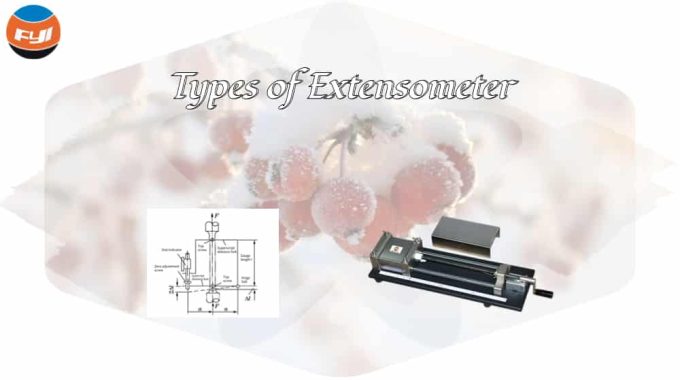
Types of Extensometer
An extensometer is an instrument that measures line deformation between two points on components and other objects. The main equipment used in tensile testing includes testing machines and extensometers. The testing machine is a system that applies tensile testing force to the sample, and controls and measures it; the extensometer is a system that measures the extension (or displacement) of the sample. During the testing of material mechanical properties, stress and strain are interdependent. Any material, as long as it is subjected to stress, will definitely produce strain; as long as it produces strain, it must be subject to stress.
Contents
Mechanical extensometer
Mechanical extensometers are mainly ball hinge extensometers. Due to its simple structure and easy operation, it is still widely used in tensile property testing.
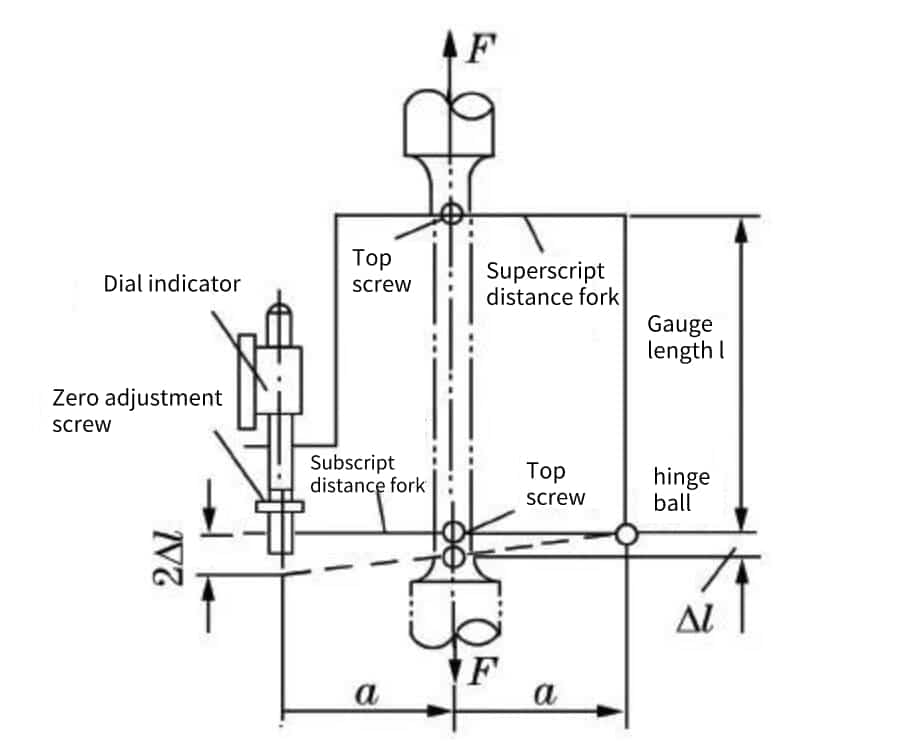
This instrument is mounted on the specimen through 4 top screws (one top screw at the front and one at the front at positions C and D). When the gauge length l of the specimen is extended by Δl, the upper gauge length fork A can be regarded as not rotating. The lower scale fork B rotates a slight angle with the spherical hinge as the center, and the sample elongation is reflected on the dial indicator. Since the distance from the axis of the dial indicator to the center of the ball hinge is twice the distance from the axis of the specimen to the center of the ball hinge, the reading of the dial indicator when the specimen is extended Δl is 2Δl.
The biggest advantage of this instrument is that it has an automatic averaging structure system, and only one reading device can be used to obtain the pure tensile elongation of the sample that eliminates the influence of eccentric tensile bending. The spherical hinge extensometer uses only a dial indicator and the instrument has a magnification of K=2000 times.
To sum up, since eccentric stretching inevitably occurs during the tensile test, the extensometers used to measure the deformation of the tensile specimen must be installed on each symmetrical side of the specimen. Use the average of these two extensometer readings as the pure tensile elongation of the specimen. (Only one extensometer that automatically takes the average value of both sides is installed)
Electronic extensometer
In recent years, with the rapid development of the computer age, another new type of extensometer has emerged—the electronic extensometer. Electronic extensometers include: resistive extensometers, capacitive extensometers, inductive extensometers, etc.
The electronic extensometer collects the strain signal into the computer so that it can be displayed simultaneously with the material stress. Compared with mechanical extensometers, it reduces human reading errors and improves measurement accuracy. Because electronic extensometers are affordable, easy to install, and easy to use online with electronic universal testing machines, electronic sensors, etc., electronic extensometers are widely used by related industries at home and abroad.
Resistive extensometer
Resistive extensometer is a type of resistive strain sensor and is the most widely used. The measurement principle of the resistance strain extensometer is mainly based on the change in resistance of the strain gauge attached to the elastic element of the extensometer. It is converted into a voltage signal through a conversion circuit, and the strain is measured through computer acquisition and stress synchronous display.
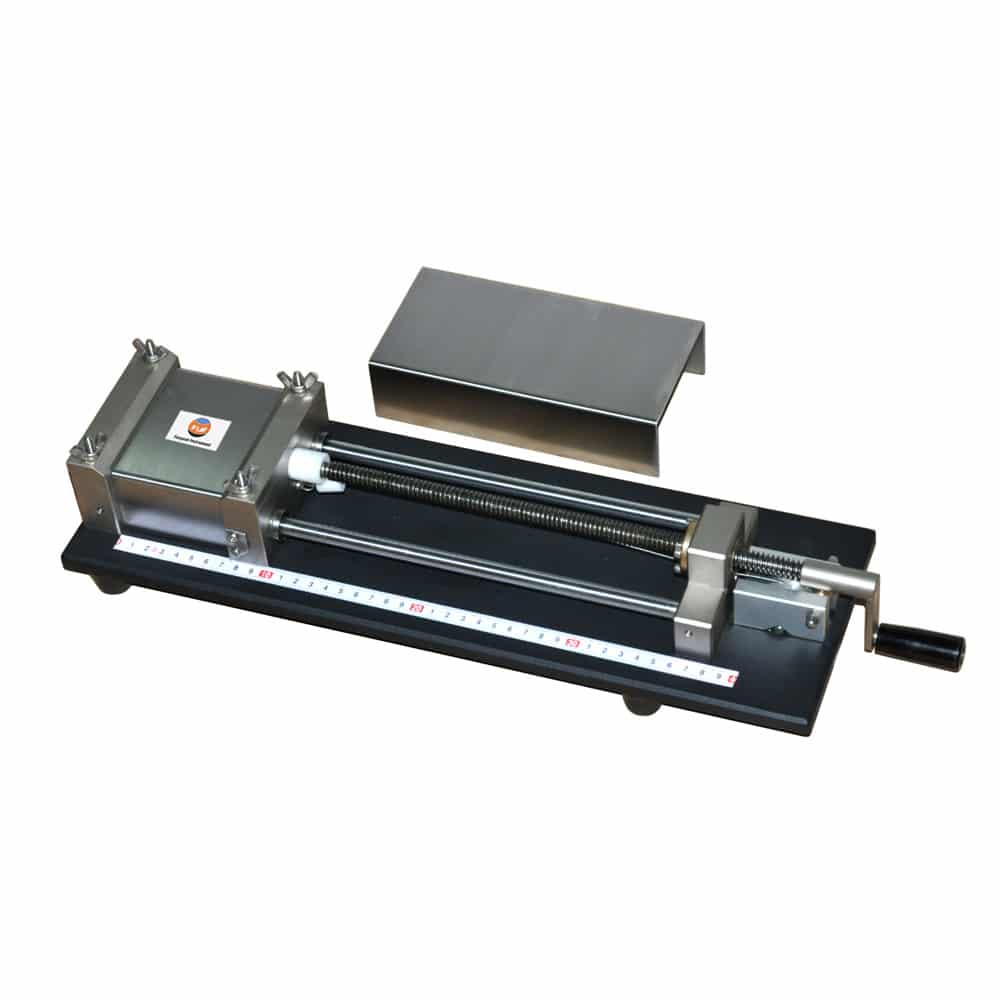
This kind of extensometer is installed on one side of the sample or on a busbar on the cylindrical surface of the sample. The extensometer used in this way is called a “single-sided electronic extensometer”. Since there is generally a coaxiality error between the upper and lower chucks of the testing machine, there may also be a coaxiality error between the clamping part and the gauge length part of the specimen. Therefore, the sample is generally operated under eccentric stretching. The result is that the elongation of the longitudinal line segment of the sample surface and the elongation of the sample axis within the gauge length section are generally not equal. This measurement method replaces the elongation of the specimen axis with the elongation measured on one side of the surface (i.e., the pure tensile elongation of the gauge length). Generally, wrong results will be obtained, which will cause certain measurement errors.
Analysis has proven that when the eccentricity is 0.1mm, the measurement error is ±8%. When the eccentricity doubles, the error also doubles. The maximum absolute value of the error can be close to 50%.
Since eccentric stretching is a combination of pure tensile deformation and pure bending deformation, the pure bending deformation causes the material on one side of the neutral layer to undergo additional tensile deformation, while the material on the other side of the neutral layer undergoes additional tensile deformation. Compression deformation. When the single-sided electronic extensometer is installed on the side subject to additional compression deformation, the deformation reflected by the single-sided electronic extensometer is compression deformation in the initial stage of the tensile process. This is the “reverse movement” phenomenon of the single-sided electronic extensometer.
When the line segment measured by the one-sided electronic extensometer is located on the neutral layer with bending deformation, the bending deformation on the neutral layer is zero. At this time, the single-sided electronic extensometer cannot measure additional bending deformation but pure tensile deformation, and its measurement results are accurate. However, eccentricity occurs randomly. In most cases, the single-sided electronic extensometer is not installed at the position of the line segment measuring the neutral layer, so the measured deformation is not the pure tensile deformation of the sample. This is why the measurement results of a single-sided electronic extensometer are extremely unstable.
Capacitive extensometer
The capacitive extensometer converts the change in the length of the object into a change in capacitance, and then converts the measured change in capacitance into the strain of the object. Since it has basically no hysteresis at high frequencies, it can be used for dynamic load testing, such as impact force testing.
Inductive extensometer
The principle of the inductive extensometer is that the deformation of the component causes the iron core to move, causing the coil inductance to change. Therefore, a voltage is generated in the output coil. By amplifying and measuring this voltage, the displacement and movement patterns of the component can be calculated.
Inductive extensometers are not as lightweight as resistive extensometers, but because they have better stability during long-term testing, they are suitable for permanent measurement devices.
Video extensometer
The video extensometer uses the principle of sub-pixel method to measure the deformation of the sample. The core is the image sensor (Charge-coupled Device, CCD) photosensitive element, which converts the light intensity into an electrical signal and outputs it according to a certain proportion. Therefore, the deformation in the longitudinal and transverse directions can be measured simultaneously in a non-contact manner. The measurement range is determined by the focal length of the lens. With lenses of different focal lengths, various measurement ranges can be obtained.
Comments are closed.
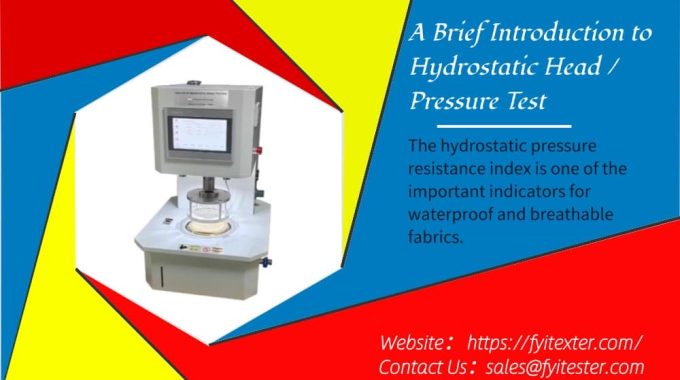
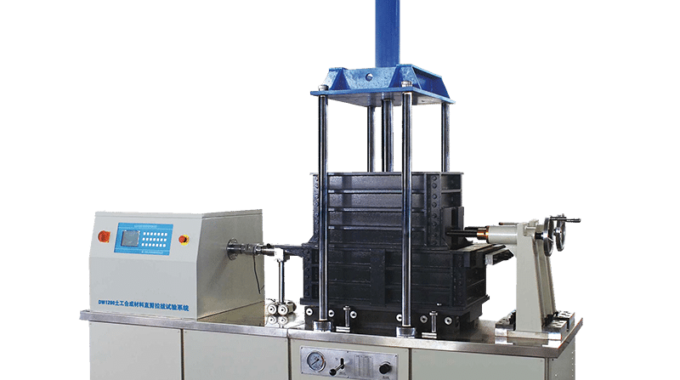

Find yourself returning to this blog time and time again for its unparalleled depth and breadth of content.
Can’t get enough of the engaging writing style and compelling content.
Every post is a testament to the author’s dedication to delivering high-quality content that resonates with readers.